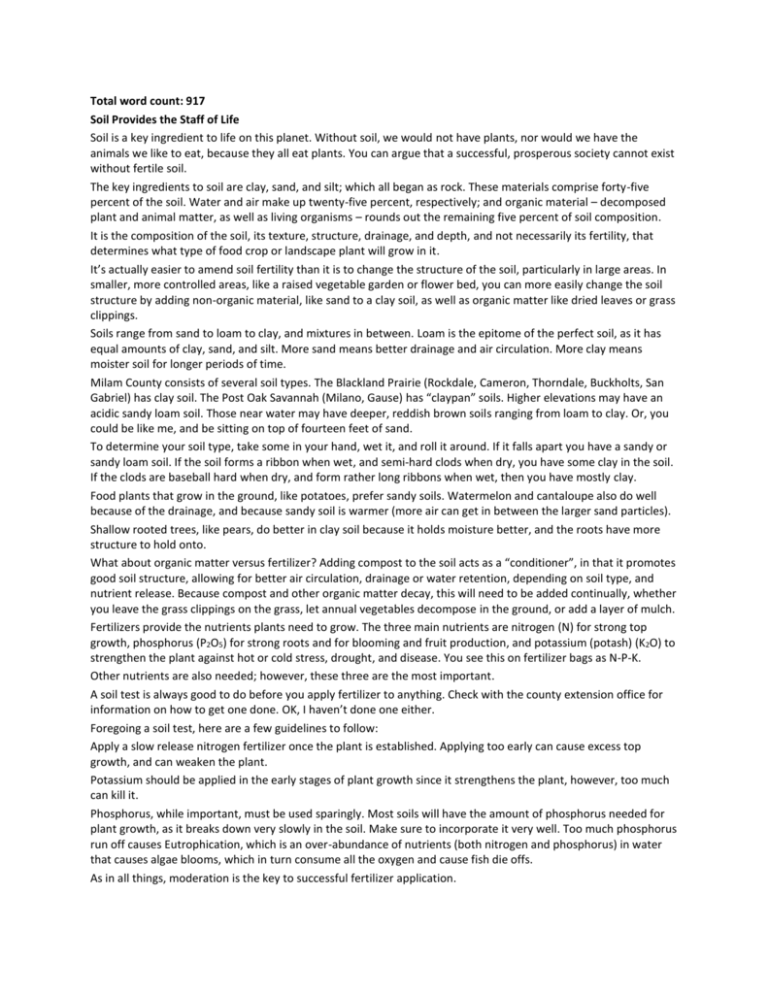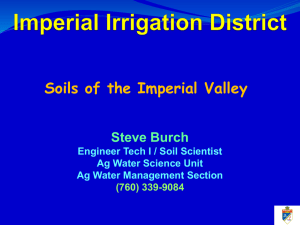09.16.10_All About Soil - Texas Master Naturalist
advertisement

Total word count: 917 Soil Provides the Staff of Life Soil is a key ingredient to life on this planet. Without soil, we would not have plants, nor would we have the animals we like to eat, because they all eat plants. You can argue that a successful, prosperous society cannot exist without fertile soil. The key ingredients to soil are clay, sand, and silt; which all began as rock. These materials comprise forty-five percent of the soil. Water and air make up twenty-five percent, respectively; and organic material – decomposed plant and animal matter, as well as living organisms – rounds out the remaining five percent of soil composition. It is the composition of the soil, its texture, structure, drainage, and depth, and not necessarily its fertility, that determines what type of food crop or landscape plant will grow in it. It’s actually easier to amend soil fertility than it is to change the structure of the soil, particularly in large areas. In smaller, more controlled areas, like a raised vegetable garden or flower bed, you can more easily change the soil structure by adding non-organic material, like sand to a clay soil, as well as organic matter like dried leaves or grass clippings. Soils range from sand to loam to clay, and mixtures in between. Loam is the epitome of the perfect soil, as it has equal amounts of clay, sand, and silt. More sand means better drainage and air circulation. More clay means moister soil for longer periods of time. Milam County consists of several soil types. The Blackland Prairie (Rockdale, Cameron, Thorndale, Buckholts, San Gabriel) has clay soil. The Post Oak Savannah (Milano, Gause) has “claypan” soils. Higher elevations may have an acidic sandy loam soil. Those near water may have deeper, reddish brown soils ranging from loam to clay. Or, you could be like me, and be sitting on top of fourteen feet of sand. To determine your soil type, take some in your hand, wet it, and roll it around. If it falls apart you have a sandy or sandy loam soil. If the soil forms a ribbon when wet, and semi-hard clods when dry, you have some clay in the soil. If the clods are baseball hard when dry, and form rather long ribbons when wet, then you have mostly clay. Food plants that grow in the ground, like potatoes, prefer sandy soils. Watermelon and cantaloupe also do well because of the drainage, and because sandy soil is warmer (more air can get in between the larger sand particles). Shallow rooted trees, like pears, do better in clay soil because it holds moisture better, and the roots have more structure to hold onto. What about organic matter versus fertilizer? Adding compost to the soil acts as a “conditioner”, in that it promotes good soil structure, allowing for better air circulation, drainage or water retention, depending on soil type, and nutrient release. Because compost and other organic matter decay, this will need to be added continually, whether you leave the grass clippings on the grass, let annual vegetables decompose in the ground, or add a layer of mulch. Fertilizers provide the nutrients plants need to grow. The three main nutrients are nitrogen (N) for strong top growth, phosphorus (P2O5) for strong roots and for blooming and fruit production, and potassium (potash) (K2O) to strengthen the plant against hot or cold stress, drought, and disease. You see this on fertilizer bags as N-P-K. Other nutrients are also needed; however, these three are the most important. A soil test is always good to do before you apply fertilizer to anything. Check with the county extension office for information on how to get one done. OK, I haven’t done one either. Foregoing a soil test, here are a few guidelines to follow: Apply a slow release nitrogen fertilizer once the plant is established. Applying too early can cause excess top growth, and can weaken the plant. Potassium should be applied in the early stages of plant growth since it strengthens the plant, however, too much can kill it. Phosphorus, while important, must be used sparingly. Most soils will have the amount of phosphorus needed for plant growth, as it breaks down very slowly in the soil. Make sure to incorporate it very well. Too much phosphorus run off causes Eutrophication, which is an over-abundance of nutrients (both nitrogen and phosphorus) in water that causes algae blooms, which in turn consume all the oxygen and cause fish die offs. As in all things, moderation is the key to successful fertilizer application. While I would argue on the side of organic fertilizers, you don’t always know what you get with them. Fish emulsion is a good all-around organic fertilizer, and compost can act as both conditioner and fertilizer. However, if you want to use bag fertilizer, especially for applying to lawns, here is how to determine the amount of each nutrient you are getting based on the N-P-K formula on the front of the bag. Multiply the weight of the fertilizer bag by the percentage of each nutrient. For example, a 30 lb. bag of fertilizer rated 24-2-8 contains: N: 24% x 30 lbs = 7.2 lbs. nitrogen P: 2% x 30 lbs = 0.6 lbs. phosphate K: 8% x 30 lbs = 2.4 lbs. potassium For the average homeowner, the lower the phosphate, the better. Try to stay away from 1-1-1 ratios, like 13-1313, and go with a fertilizer with a higher nitrogen number (N), low phosphate number (P), and middle of the road potassium number (K). +++++++++++++++++ walton.shawn@gmail.com; El Camino Real Master Naturalists: txmn.org/elcamino/







